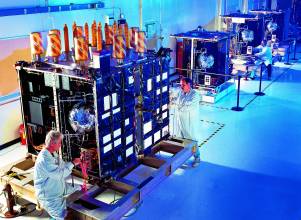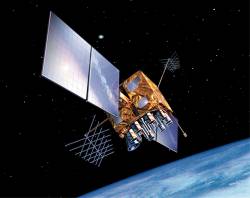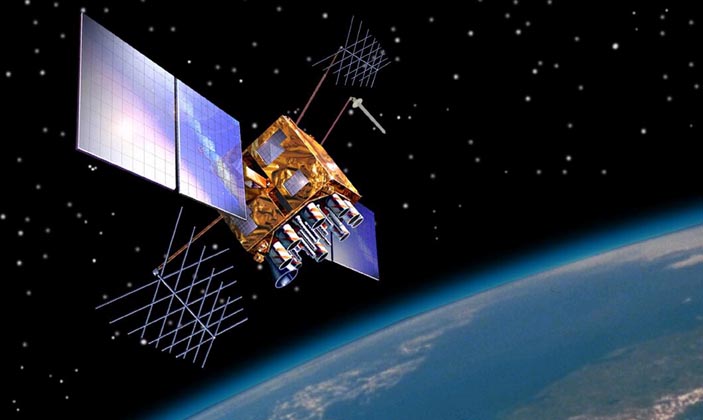The term “Correlator” is often used in discussions of GPS and GNSS receiver design. It has been used to describe devices as simple as a single exclusive OR gate through to complete “baseband” chips that include a microprocessor.
Most usually, and in this article, the term describes the hardware or software that produces all of the required correlation data for a single signal from a specific GNSS satellite signal. This is also sometimes termed a “channel.”
The term “Correlator” is often used in discussions of GPS and GNSS receiver design. It has been used to describe devices as simple as a single exclusive OR gate through to complete “baseband” chips that include a microprocessor.
Most usually, and in this article, the term describes the hardware or software that produces all of the required correlation data for a single signal from a specific GNSS satellite signal. This is also sometimes termed a “channel.”
With the open GPS civil signal at the L2 frequency (L2C) now becoming available on Block IIR-M satellites, receiver designers have the opportunity to work with a markedly different GNSS signal resource. The first IIR-M spacecraft (designated SVN53/PRN17) was launched September 25, 2005, and the second is scheduled to go into orbit on September 14, 2006. (IIR-Ms also transmit the new GPS L1/L2 military (M-code) signal, but we will not treat this issue here.)
Against that historic backdrop, then, this article examines some of the novel elements of the L2C signal and its implications for GNSS receiver correlators. Our focus will be on a technically challenging aspect of receiver operation: initial acquisition of the signal and its processing by the correlator.
But first we will review some of the key functional aspects of GNSS correlators and some of the signal parameters that affect their operation.
. . . We can more easily explain the role of a correlator if we examine its two functions separately. In a GNSS receiver, correlation is used in two distinct activities:
Acquisition. Before the receiver knows whether it can receive a certain satellite’s signal, it must “search” for it using the correlation in an ordered but relatively indiscriminate way. Effectively, many correlation trials are run for each of many code delays and Doppler frequency offsets.
Tracking. Once acquired, the receiver must still despread the received signal in order to receive data and measure pseudoranges. Several correlators are usually used to keep the local code as closely aligned to the received code as possible. To do this, a “delay-locked loop” is used, with the correlators operating within the loops, some typically ahead of the received code (“early”) and some behind (“late”).
In other words, correlation is used both to “get” the signal and to “keep” it. These actions should be considered quite separately. In this article, we concentrate on the acquisition process.
. . . Various signal parameters affect correlation. These are listed for the three GPS signals in Table 1. Both L2C and L5 have dataless sub-signals which are time-multiplexed (CM and CL) and in quadrature (I5 and Q5), respectively. Both use longer codes than L1, while L5 has a higher chipping rate. L5 also has the added complication of Neuman-Hoffman codes, which will not be further discussed here.
. . . Correlation Signal “Shape” – the L1 civilian C/A-code signal is a single BPSK modulation. Despite the fact that the L2C signal is also BPSK, it introduces another layer of complexity by having the data-carrying and dataless signals multiplexed in time. Typically, the shorter (20-millisecond) data-carrying CM code will be acquired first, then the receiver would hand over to the longer (1.5-second) dataless CL code for tracking.
. . . The beauty of the exploitation of the circular convolution is that the code in the data does not need to be well aligned with the stored data— the whole point of acquisition, after all, is to perform this alignment. So, if the CM code was chopped up into pieces smaller than 20 milliseconds, this circular convolution would no longer reflect the time domain correlation, and a receiver would need to have many stored codes.
. . . Many GPS chipsets are optimized for operation in mobile telephone handsets and, as such, are aimed at minimizing the drain on handset batteries. For such applications, the large L2C acquisition overhead presents a serious problem . .
Conclusion
In this article, we have primarily examined the implications of signal acquisition for the new L2C signal. In a typical L2C-only receiver, significantly more effort is required to acquire the signal than is the case for L1 C/A code: more than 200 times higher in the hardware case and more than 500 times higher in the software case. However, because the long CL code does not carry any data, it can be used for the long integrations required for acquisition in a weak-signal environment.
For the complete story, including figures, graphs, and images, please download the PDF of the article, above.
Acknowledgments
The author wishes to acknowledge the useful suggestions made by Eamonn Glennon of Signav Pty Ltd.






